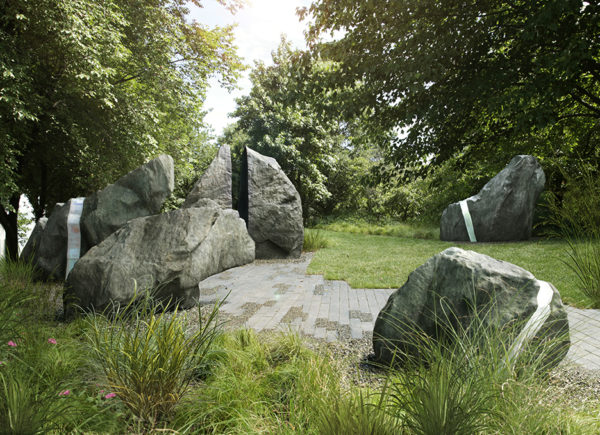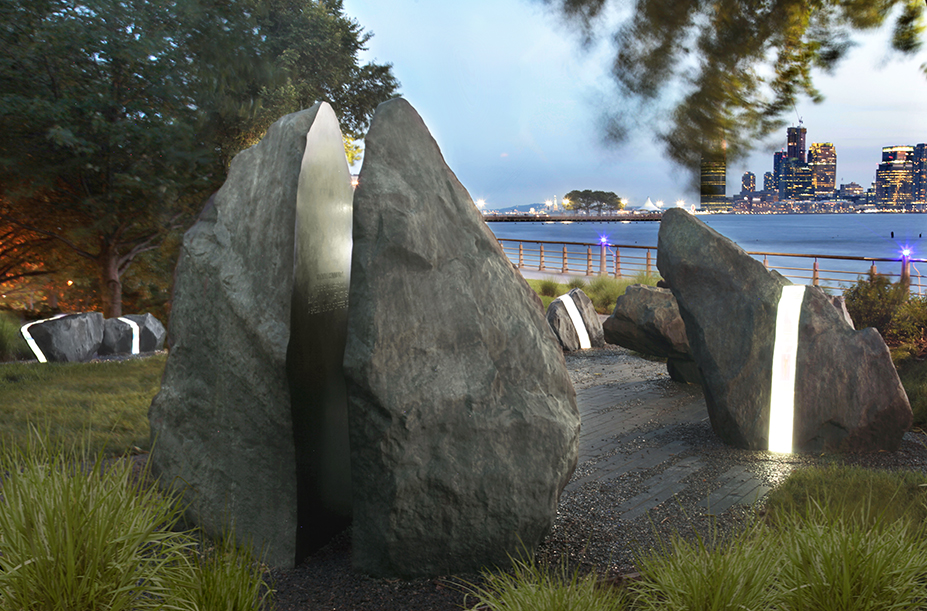
Images courtesy of the artist
A NEW LGBTQ MONUMENT
At Hudson River Park, the memorial honors victims of prejudice.
Before President Obama left office, in late 2016, the U.S. National Park Service, under his administrative lead, honored the LGBTQ community by naming the Stonewall Inn a National Monument. This historic designation was a first of its kind. No other LGBTQ identifying space had ever been listed (let alone considered) on the National Monument register. To commemorate the Stonewall Riot’s 50th anniversary, and coming just two years after President Obama’s announcement, New York is unveiling a new LGBTQ monument. Designed by artist Anthony Goicolea, the memorial, located on Hudson River Park and was commissioned by New York State to honor the LGBTQ community — including those lost in the Pulse nightclub shooting in Orlando — as well as all victims of hate, intolerance and violence.
The public monument encourages visitors to look beyond exteriors. Its large granite stones are constructed from bronze, with fragile glass creating strong unifying bonds. An inward-facing Audre Lorde quote is inscribed between the largest split stone, acting as the memorial’s inner voice. The proportion of the rocks and their circular arrangement creates a safe harbor that beckons visitors to rest upon the immovable stones. These markers become pedestals for the true monument: the community of differing people who sit, visit, commune, mourn, love and remember.
To learn more about the monument’s creation, I sent Anthony a few questions to hear more about his process in designing and what the historic-future of the space could look like.
You have cited historic structures such as Stonehenge & Easter Island as points of reference for the new monument — what is your hope for your own design and it’s own potential history? I made reference to Stonehenge and Easter Island as well as other innate circular arrangements, markers, and dolmens like megalithic stone circles of Africa, Cairns from Scotland and Ireland, pre-Columbian burial mounds, Native American tribal spots, and even park-side campfire settings. There is something about these structures that seems almost anthropologically inherent. The circular structure is automatically inward facing and introspective. If a combination of two or more people is seated on any of the rocks, a community is instantly formed.
As time goes by, the bronze stones will become warn and polished where people interact with them most. Time and use will be recorded in the memorial itself. I hope this memorial becomes a space that the community adopts and that allows the community to create its own rituals and observations.
While sexuality or homoeroticism does not take precedent in your works, what role do you believe your sexual autobiography has made itself known in your work? I grew up Cuban-American and gay in the Deep South. Trying to navigate this terrain fine-tuned my antenna to a middle ground frequency that appropriated from diametrically opposed conditions. These early ways of thinking, navigating, and seeing have infiltrated my work and the issues I want to address.
A lot of my work tackles the notion of identity and these sort of liminal or awkward in-between states. Subjects that straddle boundaries have always fascinated me. Whether it’s the space between childhood and adulthood, beauty and the grotesque, homogeneity and individualism, androgyny and sexuality… I am interested in the gestational pupate or larval state that allows one thing to become another; I am interested in transition and how people define themselves in the midst of its chaos and otherworldliness.
Can you describe what the ideal scene at the monument might look like? I am not sure I know yet. For me, it will probably be that moment when people have discovered some unintended aspect of the memorial and adopt it as their own. Like how people do rubbings at the Vietnam Memorial wall or people circle passages from Jenny Holzer’s engraving of Walt Whitman’s text at The NYC AIDS Memorial, or how people left Campbell soup cans with flowers at the base of Rob Pruitt’s Andy Warhol Statue in Union Square. Its that moment when the community which the art work serves makes it their own… that would be my ideal vision.
As Trump threatens many National Historic Monument/Park budgets, how can we ensure new design spaces such as this are not the last of its kind? VOTE! But also, be engaged. Be part of the community you live in. My husband worked with his co-founder for six long years to establish the NYC AIDS memorial. There was not a provision or budget for it. They felt strongly that there should be recognition at this particular site and they created a grassroots campaign and lobbied hard. They went to community boards, town halls, city councils, parks commissions…etc. Then they raised support, money, and good will. We still live in a country where people can have a say in their communities, they just need to speak up to be heard.

The new LGBT Monument is located at Hudson River Park, NY, NY.